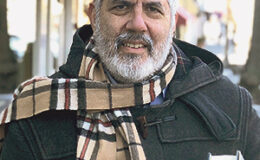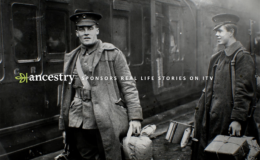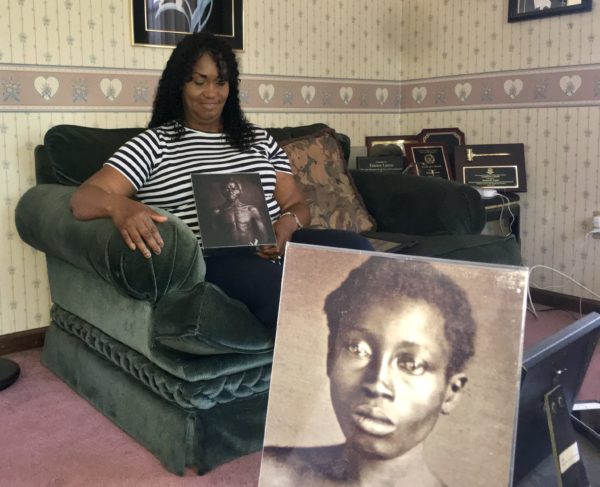

MMoore/CT Mirror
Tamara Lanier sits in her Norwich home holding a framed photo of Papa Renty, while another photo of Renty’s daughter, Delia, sits on the table in the foreground.
Note: This story was originally published on October 2, 2019.
When Tamara Lanier stands in front of crowds to make the case for her family’s link to “Papa Renty,” an enslaved African whose photograph is at the center of a lawsuit she has filed against Harvard University, her message is both global and personal.
Lanier, who lives in Norwich, has been a sought-after speaker since she filed suit in March against Harvard for its “wrongful seizure, possession and expropriation” of images of the man she says is her family’s ancestral patriarch and his daughter, Delia, both of whom were enslaved in South Carolina.
“This is a story determined to be told,” Lanier told an audience of professors, students and others last week at Central Connecticut State University, as images of Renty and others flashed on a screen behind her. “I hope at some point in the very near future … to have a successful victory in our case.”
Lanier’s message is global in the sense that her quest to wrest back from Harvard the daguerreotypes of Renty and Delia is playing out in the midst of a reinvigorated conversation about reparations for the black descendants of slaves. The issue has made its way to the 2020 Democratic debate stage, requiring most candidates vying for African American votes to take a stand on the issue.
Colleges and universities around the nation are also grappling with the issue. The finances and histories of higher education institutions founded before the Civil War are inextricably entangled with slavery. Harvard, the first institution of higher education in the United States — whose ties to slavery are plain and numerous — has yet to contend with its past, according to the complaint brought by Lanier.
The photos are stored in a museum on campus. They were commissioned by Harvard professor and naturalist Dr. Louis Agassiz, who used the images of Renty, Delia, and several other slaves to bolster his racist theories. According to historical accounts, Renty was ordered to disrobe and Delia, who has tears welling in her eyes, was stripped naked to the waist and forced to pose for the camera.
Lanier says that Harvard officials insist the 15 photos belong to the school and that she cannot prove the picture of Renty in the daguerreotype is her ancestor.
One of her lawyers, Josh Koskoff of Koskoff, Koskoff & Bieder, said the burden of proof on people like Lanier is immense.
“I think about the legal hurdles and proving you’re related to somebody,” Koskoff said. “Regardless of your color, there are hurdles, but it’s a hell of a lot easier if you are white and not a descendant of slaves … You have the hurdle of laws written by white people who take for granted things like a birth certificate or being able to know the address of your grandfather or [his] father.”
Harvard President Lawrence Bacow told the university’s student newspaper in April that he believes “the law is on our side” when it comes to ownership of the daguerreotypes. A spokesman for the university said last week that she could not comment on “pending litigation.”
There doesn’t appear to be much chance of an immediate resolution to Lanier’s lawsuit. On September 18 the parties in the case jointly moved to extend an existing stay in the case for an additional two months “as they are making progress in their active discussions related to the issues raised in the complaint,” according to court papers.
But make no mistake. For all of the broader implications of Lanier’s David and Goliath challenge of Harvard, this battle is also intensely personal – an emotionally driven attempt to claw back a piece of her history that, but for her family’s tradition of oral storytelling, would have been lost long before now.
Always remember: We’re Taylors, not Thompsons
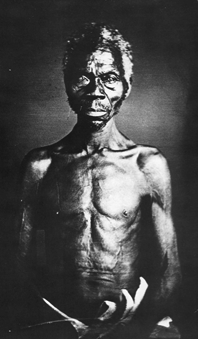
Papa Renty was one of a group of slaves Agassiz selected to pose for his photographs, which were intended to bolster his theory that black people were inferior to whites.
For enslaved South Carolinians, the punishment for literacy was harsh – a fine for the white master, with the brunt of the sanction forced upon the slave. But using a grammatical manual by a famous revolutionary soldier, Renty taught himself and others to read despite the consequences.
Renty Taylor, or Papa Renty as his family called him, labored in the fields all day and then immersed himself in the pages of Noah Webster’s Blue Back Speller at night. That speller, which sought to liberate American language from the purism of English traditions, became Renty’s path to some semblance of freedom while also challenging the prevailing theory at the time – that slaves were inferior and had a limited capacity to learn.
“My mother often told about our legacy,” Lanier, 56, told the crowd gathered at CCSU last week for a conference focused on 400 years of African American history in the United States. “It was about an African pride, pride in who they were, about a legacy of literacy, of education, of religion. My mother had amazing stories about a man she called Papa Renty and it was important that we know that.”
It was the oral tradition alive in Lanier’s family that helped lead her to the records that she says prove that Renty is her great-great-great grandfather.
“My mother often told about our legacy. It was about an African pride, pride in who they were, about a legacy of literacy, of education, of religion.”
Tamara Lanier
The break-up of slave families when members were sold combined with a general lack of documentation, Lanier said, makes it very difficult to trace a family lineage that goes back to a slave. However, using as a guide the stories told by her mother, Mattye Thompson-Lanier, and as many documents as she could find — including slave records, slave indexes, census information, death records and cemetery records — she built her case.
“I’m a direct descendant, and in every generation in my family, there is a person named Renty until my generation,” Lanier said, “and of course the men of my generation were named after their fathers.”
Lanier’s mother was born in Montgomery, Alabama in 1923 to sharecropper parents and often told her three children stories about what life was like in the Jim Crow South, where blacks worked the fields from “can to can’t,” as the saying went.
Mattye’s stories were captivating and detailed, her daughter said. She could recall the corn-husk doll from her childhood and the bus rides she took from Alabama to Connecticut as part of a summer exchange program during the 1950s.
But her impeccable memory was at its best when telling her favorite stories – those about Papa Renty, the “Black African”—a distinction that was given to note the rarity of African-born slaves after the importation of slaves to the United States was banned in 1807, the lawsuit notes.
According to Lanier, her mother would end each story with a reminder — “Always remember: We’re Taylors, not Thompsons,” a reference to the family who owned Renty and other slaves in South Carolina. The reminder served not as a rejection of the family name, but as a prompt to remember the family history.
Lanier never forgot her mother’s words and they would ultimately help her trace her lineage back to Renty, who lived on a South Carolina plantation owned by the Taylor family. She spent countless hours poring over genealogy databases and, guided by her mother’s words, made multiple trips to South Carolina libraries for information about her ancestor.
Mattye’s clue ultimately helped Lanier decipher a will in which her great-great-great-grandfather was bequeathed to a female member of his master’s family, changing his last name from Taylor to Thompson. A windfall of additional supporting documents ensued, and Lanier was able, through death records, to finally place Renty on the Taylor plantation where Dr. Louis Agassiz found him in 1850.
A reckoning?
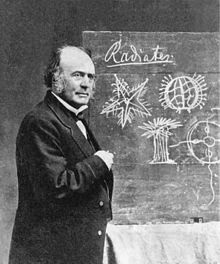
Wikipedia
Harvard Professor Louis Agassiz
Renty, who was stolen from his home in the Congo as a teenager, was about 65 when he, his daughter Delia and several other slaves were plucked from the plantation to serve as data points in support of Agassiz’s theory that black people were inferior to whites.
Agassiz’s imprimatur as a Harvard scientist gave ballast to racists’ arguments, Lanier said.
“Louis Agassiz developed a race science that said that blacks were a separate and inferior race,” Lanier said, “that we had the intellectual capabilities of a 7-month old fetus and that what we do is imitative and not creative.”
Agassiz’s message, which the complaint says was “wrapped in the trappings of science” was not just a “gift” to southerners who were contending with an abolitionist movement that was gaining traction. It was also a boon to Harvard, which had a wealthy donor in the textile business whose “livelihood depended on slavery’s preservation — or at a minimum, access to cheap black labor.”
“Agassiz spent the next fifteen years lending celebrity and ‘scientific’ legitimacy to the poisonous myth of white racial superiority,” the complaint says, “and championing the vital importance of separation of the races. Harvard steadfastly supported Agassiz every step of the way.”
Lanier’s lawyers, Koskoff and Preston C. Tisdale, have said the discussions with Harvard are confidential, but at CCSU last week they spoke openly about what they see as the university’s obligation to atone for past mistakes.
“We believe that as part of resolving this dispute that Harvard should do something that it should have done a long time ago, but it’s never too late, which is to make amends for the institution’s participation in the sort of the loss of intergenerational wealth and so forth,” said Josh Koskoff. “Basically what we have said is they ought to use this opportunity to pay reparations.”
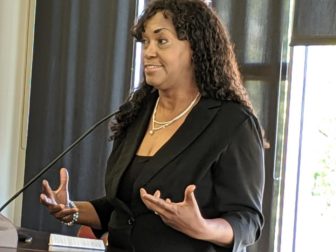
At CSCU conference Tamara Lanier talks about her family and her great great great grandfather, Renty, who was a slave.
Like all private institutions that have been around as long as Harvard, Koskoff added, the institution has ties to “slavery and Jim Crow and Reconstruction policies that improved their own economic bottom line … and of course through Agassiz had a direct effect on these policies.”
The attempt to get Harvard to reckon with its past coincides with efforts by other universities to reconcile their own history with slavery.
In 2016, Georgetown University announced it would be offering advantage in admissions to descendants of enslaved people sold to fund the school. The Jesuits, who founded and ran Georgetown, sold 272 enslaved people in 1838 to stave off crippling debt, according to the Washington Post.
In addition, Georgetown students backed a measure in April that would create a student fee to pay reparations for the university’s role in the slave trade. The fee is non-binding and must be approved by the university’s directors before it can take effect.
In the article in the Harvard Crimson in April, Harvard President Bacow refuted Lanier’s claims in the complaint that the school has refused to acknowledge its ties to slavery. He referred to former University President Drew G. Faust’s efforts to recognize Harvard’s complicity in slavery.
In 2016, Faust, along with U.S. Rep. John R. Lewis (D-Ga.), dedicated a plaque to four enslaved people who lived and worked on campus in the 18th century, the Crimson said. Further, Harvard Law School removed the school’s seal because it was based on the crest of a slave-holding family that helped endow Harvard’s first law professorship.
In addition, Bacow told the Crimson, the university does not profit from the images of Renty and Delia and only charges a “nominal fee” for reproductions. Bacow also told the Crimson that he hopes to “engage in a conversation” with the family about the photos, to see if “we can reach some reasonable accommodation.”
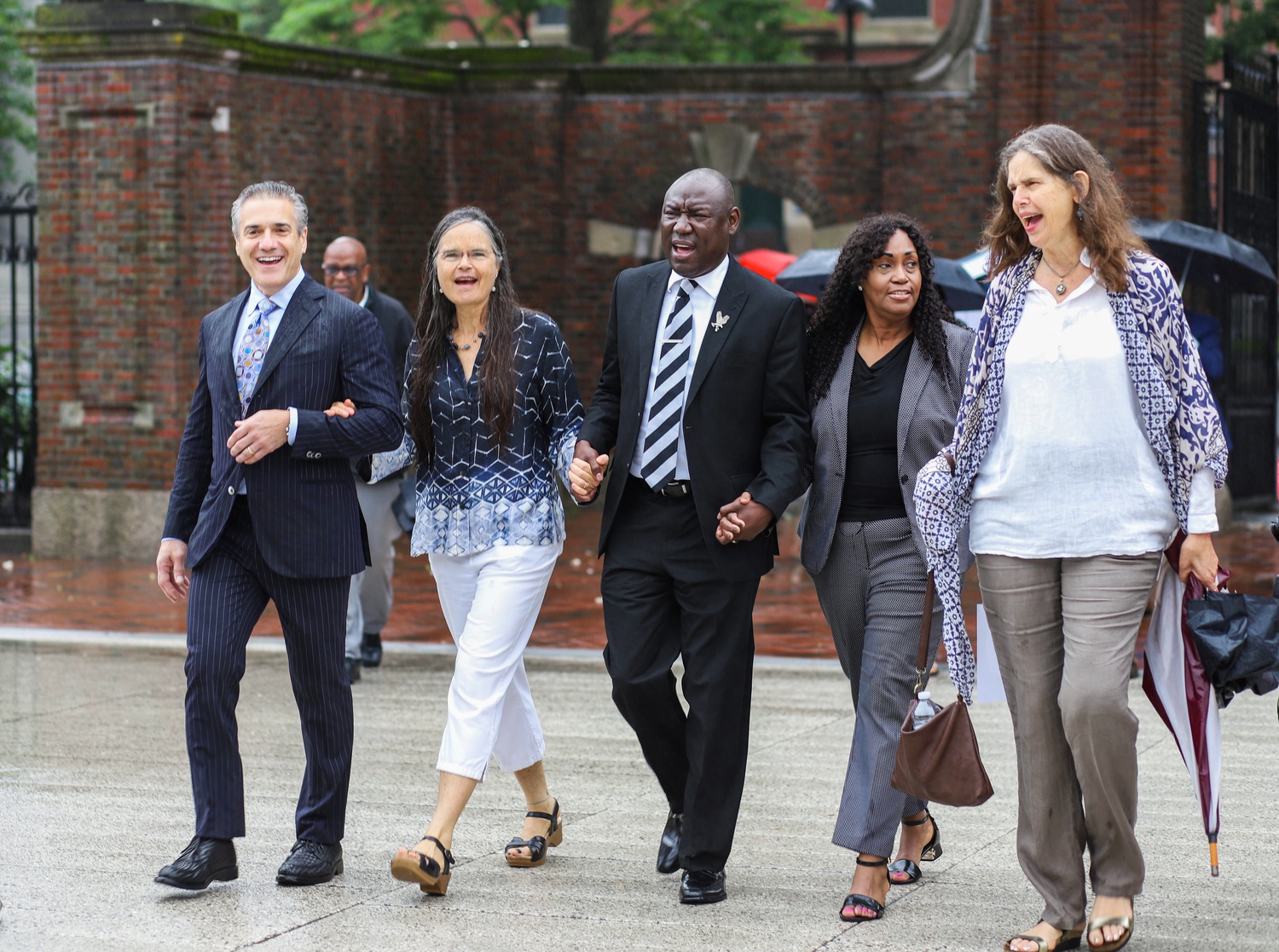
Amanda Y. Su :: Harvard Crimson
Tamara Lanier, second from right, walks arm-in-arm with two descendants of Louis Agassiz and others as they deliver a letter to Harvard President Lawrence S. Bacow.
‘Arm in arm’ with Agassiz descendants
Although Harvard hasn’t been willing to release the images to Lanier, she has received support from an unexpected corner – Agassiz’s descendants.
After a story about her case appeared in the New York Times last March, Lanier’s social media accounts blew up, overwhelmed with both supportive comments and hateful attacks. As a result, it took Lanier several weeks before she saw the Facebook message from Marian Shaw Moore, who identified herself as a descendant of Agassiz, and asked how she might be of service to Lanier in her cause.
It took Lanier a while to respond because she feared that the “hatred and ignorance” of Agassiz would somehow have been passed down to his descendants, “engrained in the DNA.”
“At first I thought, is that what it appears to be or is it another attempt to discourage me? I didn’t feel like being beat up,” Lanier said.
But the opposite was true. She learned that Moore and her sister, Susanna Moore, were appalled at what they had learned about their great-great-great-grandfather and wanted to help Lanier in any way they could. Although Lanier has spent much of her life pursuing social justice causes – both as the chief probation officer for the city of Norwich for 27 years and as an active member of the NAACP — she discovered that the Moore sisters and their families have been “more socially involved than I was. I was pleasantly surprised.”
Marian Moore, who is a lifelong activist and organizer, said she wasn’t very informed about her ancestor’s research until recently.
“Here I am preaching the gospel of reckoning and repair in my work. It was a door I wanted to walk through.”
Marian Moore, descendant of Louis Agassiz
“I was vaguely aware that he had what I filed away as problematic views on race, but I never pursued the specifics,” Moore said during a recent interview. “I really had no idea that he actively pursued what he considered to be research and that he used his platform to proactively promote these white supremacist sort of ‘scientific’ [theories].”
Moore was working last winter with a family that is interested in reckoning with the history of enslavement on their Louisiana plantation and pursuing reparations when she read the New York Times story about Agassiz.
“Here I am preaching the gospel of reckoning and repair in my work,” Moore said. “It was a door I wanted to walk through.”
Moore said that she and her family are “very much aligned with Tammy and her lawyers” in wanting Harvard to not only release the daguerreotypes, but also for Harvard to take “some kind of significant action relative to reparations on a financial level.”
In June, Lanier joined the Moore sisters as they delivered a letter signed by 43 descendants of Agassiz to Harvard calling for the return of the images of Renty and his daughter to their descendants.
“For too many years, we have ignored Agassiz’s role in promoting a pseudoscientific justification for white supremacy,” the letter read. “We see this as a collective failure to live up to our values of anti-racism and compassion. Now is the time to acknowledge and redress the harm done by Louis Agassiz.”
Susanna Moore said the sisters and Lanier delivered the letter to the Harvard president’s office “marching arm and arm, literally.”
“I call them my new sisters,” said Lanier. “We’re sisters in this current endeavor, but sitting and talking with them, it’s like we have so much in common, it seems like I’ve known them all along.”
